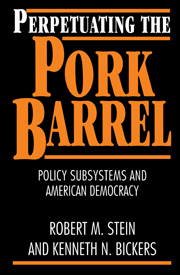Book contents
- Frontmatter
- Contents
- Tables and figures
- Acknowledgments
- PART I
- PART II
- PART III
- 4 A portfolio theory of policy subsystems
- 5 Policy subsystem adaptability and resilience in the Reagan period
- 6 PAC contributions and the distribution of domestic assistance programs
- 7 Congressional elections and the pork barrel
- PART IV
- APPENDIXES
- Notes
- Bibliography
- Index
4 - A portfolio theory of policy subsystems
Published online by Cambridge University Press: 05 June 2012
- Frontmatter
- Contents
- Tables and figures
- Acknowledgments
- PART I
- PART II
- PART III
- 4 A portfolio theory of policy subsystems
- 5 Policy subsystem adaptability and resilience in the Reagan period
- 6 PAC contributions and the distribution of domestic assistance programs
- 7 Congressional elections and the pork barrel
- PART IV
- APPENDIXES
- Notes
- Bibliography
- Index
Summary
In this chapter we turn to the development of our subsystem thesis. The literature on policy subsystems has been undergoing something of a renaissance. In recent years, public policy research has begun portraying the relationships that frequently develop between agencies, interest organizations, and legislative committees in terms that suggest fluidity, dynamism, and openness to the larger political environment (see, e.g., Hamm, 1983; McCool, 1990; Jenkins-Smith, St. Clair, and Woods, 1991). Heclo (1978), for example, describes policy subsystems as loose issue networks (cf. Berry, 1989). Kingdon (1984) argues that we should think in terms of policy communities. Cohen (1986) describes systems of variable political control involving Congress, the president, the courts, and interest groups. Sabatier and Pelkey (1987) point to potentially competitive advocacy coalitions spanning multiple actors in a policy domain. Meier's (1985) synthesis of the regulatory literature treats subsystems as interconnected sets of dyadic linkages, which may be consensual or conflictual, between agencies, subnational units of government, legislative subcommittees, industry groups, interest advocacy groups, and assorted others. All of these views reject the classic depiction of policy subsystems as “iron triangles,” composed of informal, but durable, linkages between executive agencies, legislative committees or subcommittees, and special interest groups (Lowi, 1969; McConnell, 1966; Freeman, 1965; Cater, 1964; Truman, 1951).
Taken together, this recent work suggests that the “iron triangle” literature was seriously deficient in not recognizing the conditions under which the insularity of subsystems could be breached from the outside by the rise of new interest claimants and issues or from the inside by shifting alliances and loss of consensus.
- Type
- Chapter
- Information
- Perpetuating the Pork BarrelPolicy Subsystems and American Democracy, pp. 47 - 69Publisher: Cambridge University PressPrint publication year: 1995

